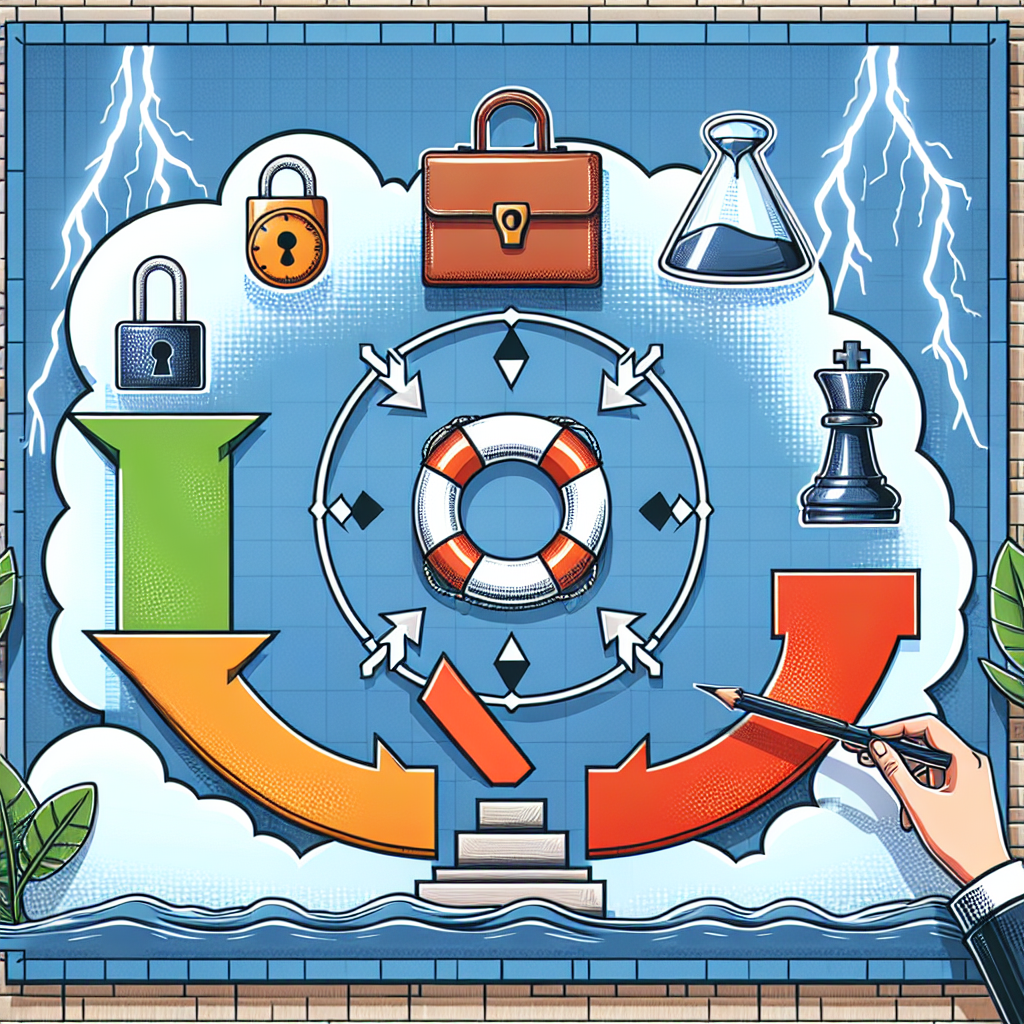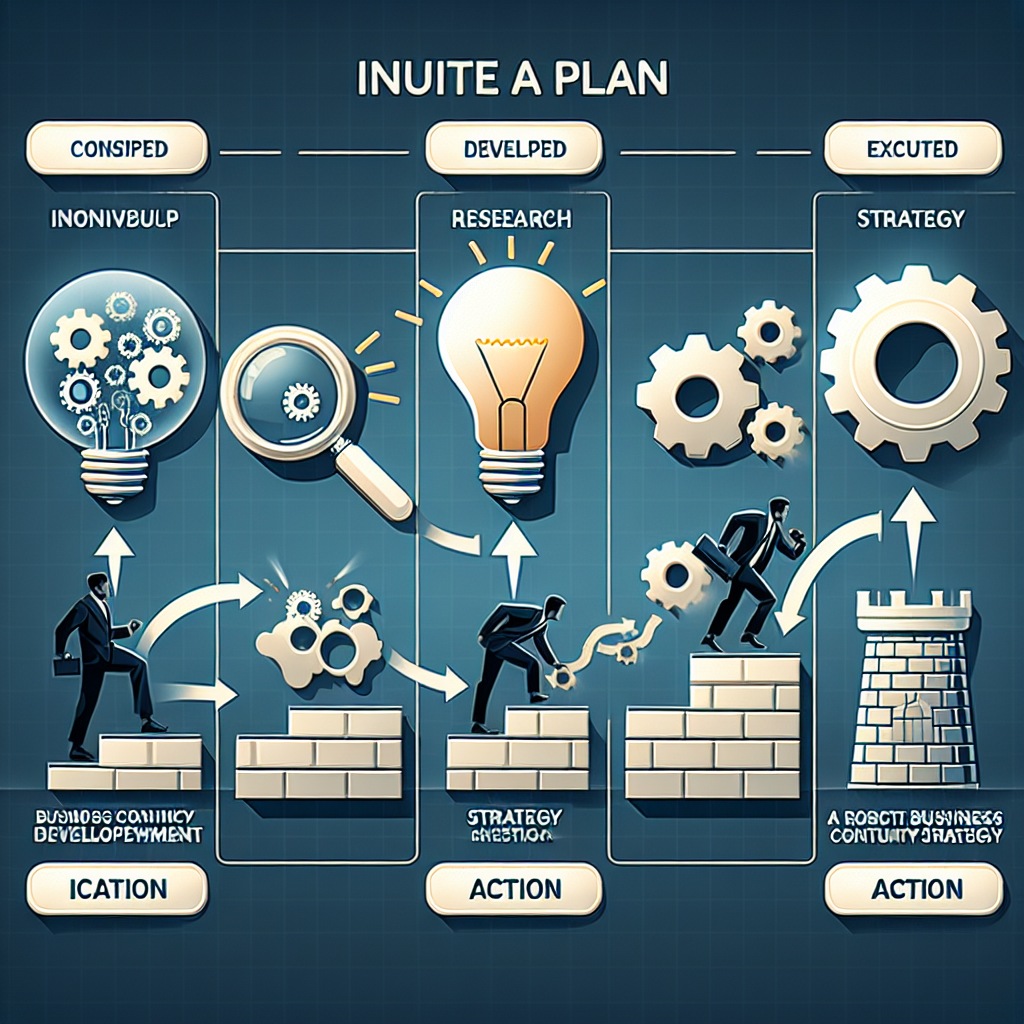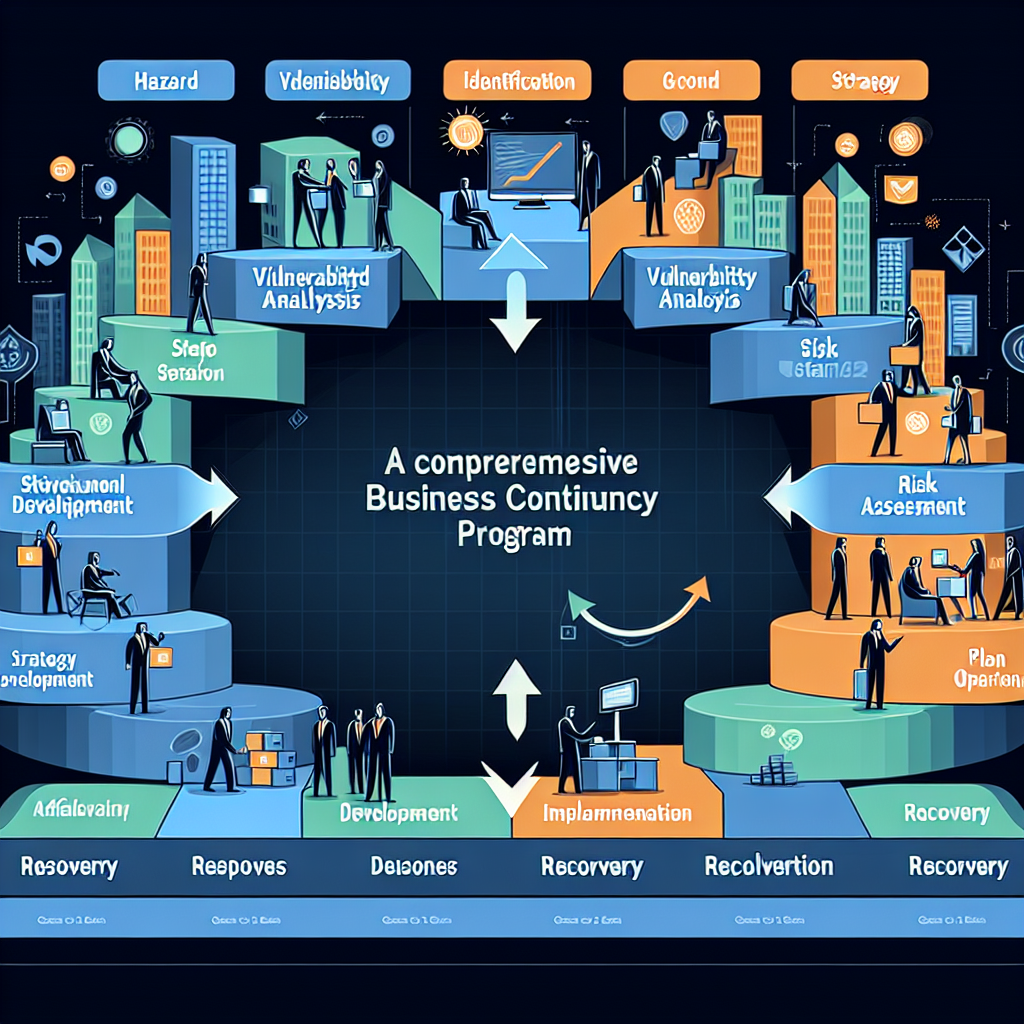Your cart is currently empty!
Tag: Steps

5 Key Steps to Building a Strong Disaster Recovery Program
Natural disasters, cyber attacks, and other unforeseen events can wreak havoc on businesses of all sizes. That’s why having a strong disaster recovery program in place is crucial to ensure the continuity of operations and minimize downtime in the event of a disaster. Here are five key steps to building a robust disaster recovery program:1. Conduct a risk assessment: The first step in building a disaster recovery program is to identify potential risks and vulnerabilities that could impact your business. This includes natural disasters such as floods, hurricanes, and earthquakes, as well as cyber threats like ransomware attacks and data breaches. By conducting a thorough risk assessment, you can prioritize your resources and focus on mitigating the most critical risks.
2. Develop a comprehensive disaster recovery plan: Once you have identified the potential risks, it’s important to develop a detailed disaster recovery plan that outlines the steps to take in the event of a disaster. This plan should include procedures for data backup and recovery, communication protocols, and roles and responsibilities for key personnel. It’s essential to regularly review and update the plan to ensure it remains relevant and effective.
3. Implement backup and recovery solutions: Data is a critical asset for businesses, so it’s essential to have robust backup and recovery solutions in place. This could include cloud-based backup services, offsite data storage, and regular data backups to ensure that critical information is secure and accessible in the event of a disaster. Testing these backups regularly is also crucial to ensure that they can be restored quickly and effectively.
4. Establish a communication plan: Communication is key during a disaster, so it’s important to establish a clear and effective communication plan. This should include contact information for key personnel, emergency contacts, and stakeholders, as well as protocols for communicating with employees, customers, and vendors. Regular communication drills and exercises can help ensure that everyone knows their roles and responsibilities in the event of a disaster.
5. Train and educate employees: Employees are often the first line of defense in a disaster, so it’s essential to train and educate them on the company’s disaster recovery plan. This could include regular training sessions, tabletop exercises, and awareness campaigns to ensure that everyone understands their roles and responsibilities. By empowering employees to take action during a disaster, you can help minimize downtime and ensure the continuity of operations.
In conclusion, building a strong disaster recovery program is essential for businesses to mitigate risks and ensure continuity of operations in the event of a disaster. By following these five key steps, businesses can better prepare for unforeseen events and minimize the impact on their operations. Remember, it’s better to be proactive and prepared than to be caught off guard when disaster strikes.

5 Key Steps to Ensure Business Continuity in Times of Crisis
In today’s unpredictable business landscape, it is more important than ever for companies to have a solid plan in place to ensure business continuity in times of crisis. Whether it’s a natural disaster, a cyber attack, or a global pandemic, having a plan in place can mean the difference between a company surviving or shutting down.Here are 5 key steps to ensure business continuity in times of crisis:
1. Develop a Business Continuity Plan: The first step in ensuring business continuity is to develop a comprehensive business continuity plan. This plan should outline the steps that need to be taken in the event of a crisis, including who is responsible for what tasks, how communication will be handled, and what resources are available to the company.
2. Identify Critical Functions and Processes: In order to prioritize resources during a crisis, it is important to identify the critical functions and processes that are essential to the operation of the business. By focusing on these key areas, companies can ensure that they are able to continue operating even in the face of a crisis.
3. Implement Remote Work Policies: In times of crisis, it may be necessary for employees to work remotely in order to maintain business operations. Companies should have remote work policies in place that outline expectations for employees working from home, as well as provide the necessary technology and tools to enable remote work.
4. Test and Update the Plan Regularly: A business continuity plan is only effective if it is regularly tested and updated. Companies should conduct regular drills and simulations to ensure that employees are familiar with the plan and know what to do in the event of a crisis. Additionally, the plan should be updated regularly to reflect changes in the business environment and emerging threats.
5. Establish Communication Channels: Communication is key in times of crisis, both internally with employees and externally with customers and stakeholders. Companies should establish clear communication channels, such as a designated crisis communication team and a system for disseminating information quickly and efficiently.
By following these 5 key steps, companies can ensure that they are prepared to weather any crisis that may come their way. Business continuity planning is an essential part of risk management and can mean the difference between a company surviving a crisis or shutting down. It is never too early to start developing a plan and ensuring that your business is prepared for whatever the future may hold.

3 Key Steps to Creating a Resilient Disaster Recovery Plan
In today’s unpredictable world, it’s more important than ever for businesses to have a resilient disaster recovery plan in place. Natural disasters, cyberattacks, and other unforeseen events can wreak havoc on a company’s operations and finances. Having a solid disaster recovery plan can help businesses minimize downtime, protect their data, and ensure a quick recovery in the event of a crisis.Here are three key steps to creating a resilient disaster recovery plan:
1. Conduct a thorough risk assessment: The first step in creating a disaster recovery plan is to identify potential risks and vulnerabilities that could impact your business. This includes natural disasters such as hurricanes, earthquakes, and floods, as well as cybersecurity threats like ransomware attacks and data breaches. Consider conducting a risk assessment to evaluate the likelihood and potential impact of these events on your business. This will help you prioritize your efforts and resources to address the most critical risks.
2. Develop a comprehensive plan: Once you have identified the risks, it’s important to develop a comprehensive disaster recovery plan that outlines how your business will respond and recover in the event of a crisis. This plan should include detailed procedures for mitigating risks, protecting data, and restoring operations. It should also establish clear roles and responsibilities for key personnel and outline communication protocols for keeping employees, customers, and stakeholders informed during a crisis.
3. Test and update regularly: A disaster recovery plan is only effective if it is regularly tested and updated to ensure its effectiveness. Conducting regular drills and simulations can help identify gaps in your plan and allow you to make necessary adjustments. It’s also important to stay informed about emerging threats and technologies that could impact your business and update your plan accordingly. By regularly testing and updating your disaster recovery plan, you can ensure that your business is prepared to handle any crisis that comes its way.
In conclusion, creating a resilient disaster recovery plan is essential for businesses to protect themselves from unforeseen events and ensure a quick recovery in the event of a crisis. By conducting a thorough risk assessment, developing a comprehensive plan, and regularly testing and updating it, businesses can minimize downtime, protect their data, and maintain their operations during a crisis. Investing in a resilient disaster recovery plan is a smart decision that can ultimately save your business time, money, and reputation in the long run.
Bianca Censori steps out in sheer tights alongside Kanye West in Tokyo after weeks away from spotlight
Jan 31, 2025 06:12 PM IST
After weeks away from the public eye, Kanye West and Bianca Censori reemerged at Tokyo International Airport.
Bianca Censori, the Italian fashion icon, made a stunning return to the spotlight as she stepped out in Tokyo alongside Kanye West. The duo turned heads as they were spotted walking hand in hand, with Bianca looking effortlessly chic in a pair of sheer tights.After weeks away from the public eye, Bianca certainly made a statement with her bold fashion choice. The sheer tights added a touch of edginess to her outfit, while still maintaining her signature sense of style.
Paired with a sleek black mini dress and statement heels, Bianca looked every bit the fashionista that she is known to be. And of course, Kanye West was by her side, looking equally stylish in his own ensemble.
It’s clear that Bianca Censori is back and better than ever, and we can’t wait to see what other fashionable moments she has in store for us. Stay tuned for more updates on this dynamic duo’s adventures in Tokyo!
Tags:
Bianca Censori, Kanye West, Tokyo, sheer tights, celebrity fashion, paparazzi photos, red carpet style, celebrity sightings, Tokyo fashion week, celebrity news, celebrity appearances, fashion influencer, street style, fashion trends
#Bianca #Censori #steps #sheer #tights #Kanye #West #Tokyo #weeks #spotlight
The Key Steps to a Successful Data Backup and Recovery Plan
In today’s digital age, data is the lifeblood of any organization. From customer information to financial records, businesses rely on their data to operate efficiently and effectively. However, data is vulnerable to a variety of threats, including hardware failure, cyberattacks, human error, and natural disasters. That’s why having a robust data backup and recovery plan is essential for ensuring the continuity of your business operations.Here are the key steps to a successful data backup and recovery plan:
1. Identify critical data: The first step in creating a data backup and recovery plan is to identify the critical data that your organization can’t afford to lose. This includes customer records, financial information, intellectual property, and any other data that is essential for your business operations.
2. Choose the right backup solution: There are several backup solutions available, including on-site backups, off-site backups, and cloud backups. It’s important to choose a solution that meets your organization’s needs in terms of cost, scalability, and reliability.
3. Establish a backup schedule: Once you’ve chosen a backup solution, it’s important to establish a backup schedule that ensures your data is backed up regularly. This could be daily, weekly, or monthly backups, depending on the volume of data and the frequency of changes.
4. Test your backups: Regularly testing your backups is essential to ensure that they are working properly and that you can recover your data in the event of a disaster. Make sure to test both the backup process and the recovery process to identify any issues before they become critical.
5. Implement a recovery plan: In addition to having a backup plan, it’s important to have a recovery plan in place that outlines the steps to take in the event of a data loss. This includes identifying who is responsible for managing the recovery process, how to access backup data, and how to restore systems and applications.
6. Train your staff: Your employees play a crucial role in ensuring the success of your data backup and recovery plan. Make sure to train them on best practices for data protection, including how to recognize potential threats and how to recover data in the event of a disaster.
7. Monitor and update your plan: Finally, it’s important to regularly monitor and update your data backup and recovery plan to ensure that it remains effective in the face of evolving threats and technology. This includes conducting regular audits of your backup systems, testing your recovery process, and updating your plan as needed.
In conclusion, a successful data backup and recovery plan is essential for protecting your organization’s most valuable asset – its data. By following these key steps, you can ensure that your business is prepared to recover quickly and effectively from any data loss event.

6 Essential Steps for Creating a Disaster Recovery Plan
In today’s fast-paced and ever-changing world, it’s essential for businesses to have a disaster recovery plan in place. Whether it’s a natural disaster, cyber attack, or any other unforeseen event, having a plan in place can mean the difference between your business surviving or folding.Here are six essential steps for creating a disaster recovery plan:
1. Identify potential risks: The first step in creating a disaster recovery plan is to identify the potential risks that your business may face. This could include natural disasters such as earthquakes, floods, or hurricanes, as well as man-made disasters like cyber attacks or data breaches. By identifying these risks, you can better prepare for them and mitigate their impact on your business.
2. Determine critical systems and data: Once you have identified the potential risks, the next step is to determine which systems and data are critical to your business operations. This could include customer data, financial records, or any other information that is essential for your business to function. By determining which systems and data are critical, you can prioritize their recovery in the event of a disaster.
3. Develop a recovery strategy: After identifying the potential risks and critical systems and data, the next step is to develop a recovery strategy. This could involve creating backups of your data, implementing security measures to prevent cyber attacks, or developing a communication plan in the event of a disaster. By developing a recovery strategy, you can ensure that your business can quickly recover from a disaster and minimize downtime.
4. Test your plan: Once you have developed a disaster recovery plan, it’s essential to test it regularly to ensure that it will work when needed. This could involve running simulations of various disaster scenarios, testing backups of your data, or conducting drills with your employees. By testing your plan, you can identify any weaknesses and make adjustments to improve its effectiveness.
5. Communicate the plan: It’s crucial to communicate your disaster recovery plan to all employees and stakeholders in your business. This could involve providing training on the plan, creating a communication plan in the event of a disaster, or ensuring that everyone knows their role in the recovery process. By communicating the plan, you can ensure that everyone is prepared and knows what to do in the event of a disaster.
6. Review and update the plan: Finally, it’s essential to regularly review and update your disaster recovery plan to ensure that it remains relevant and effective. This could involve revisiting your risk assessment, testing your plan regularly, or incorporating new technologies and best practices. By reviewing and updating your plan, you can ensure that your business is prepared for any disaster that may come its way.
In conclusion, creating a disaster recovery plan is essential for businesses of all sizes. By following these six essential steps, you can better prepare your business for any unforeseen event and ensure its survival in the face of disaster.

Creating a Proactive Maintenance Plan: Steps to Get Started
Creating a proactive maintenance plan is essential for ensuring the smooth operation of your equipment and facilities. By taking a proactive approach to maintenance, you can identify and address potential issues before they become major problems, reducing downtime and increasing efficiency. Here are some steps to help you get started on creating a proactive maintenance plan:1. Assess your current maintenance practices: Before you can create a proactive maintenance plan, you need to understand your current maintenance practices. Take stock of the equipment and facilities you have, the maintenance tasks that are currently being performed, and any recurring issues that you have experienced. This will help you identify areas that need improvement and guide your proactive maintenance efforts.
2. Identify critical assets: Not all equipment and facilities are created equal. Some assets are more critical to your operations than others and require more attention. Identify the critical assets that are essential to your business and prioritize them in your maintenance plan. Focus your proactive maintenance efforts on these assets to ensure their continued reliability and performance.
3. Develop a preventive maintenance schedule: Preventive maintenance involves performing regular maintenance tasks on a scheduled basis to prevent breakdowns and prolong the life of your equipment. Develop a preventive maintenance schedule that outlines the tasks that need to be performed, the frequency at which they should be done, and the resources required. This will help you stay on top of maintenance tasks and prevent issues before they occur.
4. Implement predictive maintenance techniques: Predictive maintenance involves using data and analytics to predict when equipment is likely to fail so that maintenance can be performed before a breakdown occurs. Implement predictive maintenance techniques, such as vibration analysis, infrared thermography, and oil analysis, to monitor the condition of your equipment and identify potential issues early on. This will help you address problems before they escalate and reduce the likelihood of unexpected downtime.
5. Invest in maintenance management software: A proactive maintenance plan requires proper organization and tracking of maintenance activities. Invest in maintenance management software that can help you schedule and track maintenance tasks, manage work orders, and monitor equipment performance. This will streamline your maintenance operations and make it easier to stay on top of maintenance activities.
6. Train your maintenance team: A proactive maintenance plan is only as effective as the people who implement it. Ensure that your maintenance team is properly trained on the proactive maintenance techniques and tools that you are implementing. Provide ongoing training and support to help them effectively carry out maintenance tasks and contribute to the success of your maintenance plan.
By following these steps, you can create a proactive maintenance plan that helps you identify and address potential issues before they become major problems. Taking a proactive approach to maintenance will not only improve the reliability and efficiency of your equipment and facilities but also save you time and money in the long run. Start implementing these steps today to get started on creating a proactive maintenance plan for your business.

Data Backup and Recovery: Essential Steps for Disaster Preparedness
In today’s digital age, data is the lifeblood of any organization. From customer information to financial records, data is crucial for the day-to-day operations of businesses. However, data is also vulnerable to a variety of threats, including natural disasters, cyber attacks, and hardware malfunctions. In order to protect their data and ensure business continuity in the event of a disaster, organizations must have a comprehensive data backup and recovery plan in place.Data backup is the process of creating copies of data and storing them in a secure location. This ensures that even if the original data is lost or corrupted, a backup copy can be used to restore it. There are several methods of data backup, including onsite backups (such as external hard drives or tape drives) and offsite backups (such as cloud storage or remote servers). It is recommended to have a combination of both onsite and offsite backups to ensure redundancy and mitigate the risk of data loss.
In addition to regular data backups, organizations must also have a robust data recovery plan in place. Data recovery is the process of restoring data from backups in the event of a disaster. This involves identifying the cause of the data loss, selecting the appropriate backup copy, and restoring the data to its original state. It is important to test the data recovery process regularly to ensure that it is effective and efficient.
When developing a data backup and recovery plan, there are several essential steps that organizations should follow:
1. Identify critical data: Identify the data that is essential for the day-to-day operations of the organization. This may include customer information, financial records, and intellectual property.
2. Determine backup frequency: Determine how frequently data should be backed up based on the organization’s needs and risk tolerance. Critical data may require more frequent backups than less important data.
3. Select backup methods: Choose the appropriate backup methods based on the organization’s budget, resources, and technical capabilities. Consider using a combination of onsite and offsite backups for redundancy.
4. Implement data encryption: Encrypting data before it is backed up ensures that it remains secure and protected from unauthorized access.
5. Develop a data recovery plan: Develop a detailed data recovery plan that outlines the steps to be taken in the event of a data loss. This plan should include procedures for identifying the cause of the data loss, selecting the appropriate backup copy, and restoring the data.
6. Test the data recovery plan: Regularly test the data recovery plan to ensure that it is effective and can be executed quickly in the event of a disaster.
By following these essential steps for data backup and recovery, organizations can ensure that their data is protected and that they are prepared to handle any potential disasters. Data is a valuable asset, and investing in a comprehensive data backup and recovery plan is essential for disaster preparedness and business continuity.

5 Key Steps to Developing a Robust Business Continuity Strategy
In today’s fast-paced and unpredictable business environment, having a robust business continuity strategy is essential for ensuring the survival and success of any organization. A solid business continuity plan can help companies mitigate risks, minimize disruptions, and maintain operations in the face of unforeseen events such as natural disasters, cyber-attacks, or pandemics. Here are five key steps to developing a strong business continuity strategy:1. Conduct a Business Impact Analysis (BIA): The first step in developing a business continuity strategy is to conduct a comprehensive business impact analysis to identify potential risks and their potential impact on the organization. This analysis should include assessing the critical processes, systems, and resources that are essential for the operation of the business, as well as identifying vulnerabilities and dependencies that could affect these key areas.
2. Define Recovery Objectives: Once the risks have been identified, the next step is to define recovery objectives for each critical process, system, or resource. This involves determining the maximum allowable downtime for each area and establishing recovery time objectives (RTOs) and recovery point objectives (RPOs) that will guide the development of the business continuity plan.
3. Develop a Business Continuity Plan: Based on the findings of the business impact analysis and recovery objectives, organizations should develop a comprehensive business continuity plan that outlines the steps to be taken in the event of a disruption. This plan should include detailed procedures for responding to specific scenarios, as well as communication protocols, resource allocation strategies, and recovery strategies.
4. Test and Update the Plan: Once the business continuity plan has been developed, it is crucial to regularly test and update the plan to ensure its effectiveness. This may involve conducting tabletop exercises, simulations, or full-scale drills to identify gaps and weaknesses in the plan and make necessary adjustments. It is also important to review and update the plan regularly to account for changes in the business environment and emerging threats.
5. Train and Educate Employees: Finally, organizations should invest in training and educating employees on the business continuity plan and their roles and responsibilities in the event of a disruption. This may include conducting training sessions, workshops, or seminars to ensure that all employees are aware of the plan and are prepared to act quickly and effectively in an emergency.
In conclusion, developing a robust business continuity strategy is essential for ensuring the resilience and longevity of any organization. By following these key steps and investing in thorough planning, testing, and training, businesses can better prepare for and respond to disruptions, safeguarding their operations and reputation in the face of adversity.

From Risk Assessment to Recovery: Steps for Implementing a Comprehensive Business Continuity Program
In today’s fast-paced business environment, disruptions can occur at any time, from natural disasters to cyber attacks. It is crucial for organizations to have a comprehensive business continuity program in place to ensure that they can continue operating and serving their customers in the face of adversity. From risk assessment to recovery, there are several steps that organizations can take to implement a robust business continuity program.The first step in implementing a business continuity program is conducting a thorough risk assessment. This involves identifying potential threats and vulnerabilities that could disrupt business operations, such as natural disasters, cyber attacks, or supply chain disruptions. By understanding the risks that the organization faces, business continuity planners can develop strategies to mitigate these risks and ensure that critical business functions can continue in the event of a disruption.
Once the risks have been identified, the next step is to create a business continuity plan. This plan should outline the steps that need to be taken to ensure that critical business functions can continue operating during a disruption. It should include detailed procedures for responding to different types of disruptions, as well as a communication plan for keeping employees, customers, and other stakeholders informed.
Training and testing are also essential components of a comprehensive business continuity program. All employees should be trained on their roles and responsibilities in the event of a disruption, and regular drills and exercises should be conducted to test the effectiveness of the business continuity plan. This will help to ensure that everyone knows what to do in an emergency and that the organization can respond quickly and effectively to any disruptions that occur.
In the event of a disruption, the final step in the business continuity process is recovery. This involves restoring critical business functions and minimizing the impact of the disruption on the organization. Recovery efforts may include restoring IT systems, relocating employees to alternative work locations, and communicating with customers and other stakeholders about the status of operations.
By following these steps and implementing a comprehensive business continuity program, organizations can better prepare for and respond to disruptions, ensuring that they can continue operating and serving their customers even in the face of adversity. With careful planning, training, and testing, organizations can minimize the impact of disruptions and recover quickly, maintaining their reputation and competitive advantage in the marketplace.

